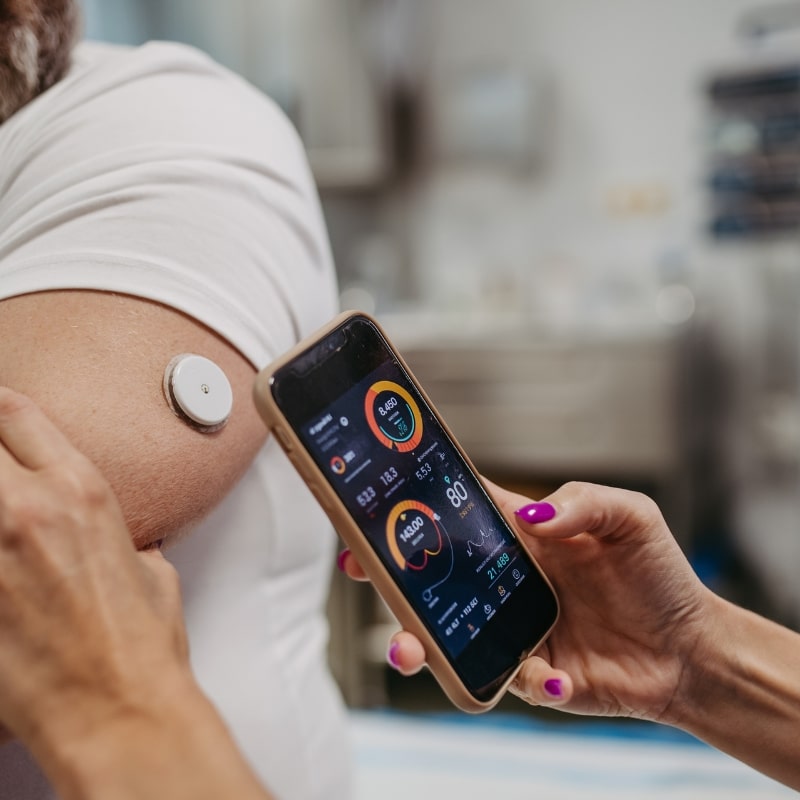Healthcare feels more personal nowadays because it is more focused on staying ahead of illness instead of reacting to it. One reason behind that shift is wearable technology. These small devices help track everything from heart rate to sleep patterns, giving patients and providers instant updates about what’s happening in the body.
At Zeam Health & Wellness, we are excited about what this means for the communities we serve across Folsom, Roseville, Sacramento, and through our online care options. In this blog, we’ll take a closer look at how remote patient monitoring (RPM) through wearable tech is reshaping preventative care and why it matters more than ever.
A Look at Remote Patient Monitoring and Wearable Tech
Remote patient monitoring allows clinicians to track a patient’s health outside the walls of a clinic or hospital. Devices can monitor heart rate, blood pressure, oxygen levels, glucose, sleep, and more, all from home. Some of these tools work continuously and send real-time data straight to a provider’s system. Others rely on patients to check and report key vitals.
Wearable devices are often at the center of RPM systems. From smartwatches that detect arrhythmias to continuous glucose monitors synced with mobile apps, these tools offer both insight and independence.
RPM can now monitor a wide range of chronic and acute conditions, including:
- Cardiovascular disease
- Diabetes
- Asthma
- Cancer
- Pregnancy-related complications
The pandemic accelerated adoption, but the momentum is lasting. Healthcare practitioners across the globe view RPM as not just useful but essential for the future of care.
The Preventative Health Power of Continuous Monitoring
Preventative healthcare is no longer just about check-ups and screenings. Wearables allow care to happen between visits, alerting providers to changes before they become crises.
In a 2022 Mayo Clinic study, patients using RPM tools saw fewer emergency visits, fewer hospitalizations, and better outcomes overall. Why? When symptoms start to shift, clinicians are able to catch it early and act fast. This approach saves lives, especially for those with chronic conditions.
Continuous monitoring also supports realistic views of a patient’s health. For example, someone who experiences “white coat syndrome” may only show high blood pressure during in-person appointments. A wearable cuff used at home paints a truer picture. Over time, data trends can help shape lifestyle changes, medication adjustments, and more personalized treatment.
RPM Use Cases Across Specialties
The value of RPM becomes clear when looking at how it works across different health scenarios.
Cardiovascular Care
Smartwatches and ECG-enabled patches can detect atrial fibrillation and irregular rhythms. A global study by Ding et al. found that over 62.3% of practitioners recommend FDA-approved devices to help monitor heart health. Patients gain peace of mind, while providers gain timely, actionable insights.
Respiratory Conditions
For asthma and COPD, RPM tools like inhaler sensors and mobile spirometers track medication use and lung function. Practitioners in Hollenbach’s study welcomed these tools as effective additions to care.
Maternal Health Monitoring
Pregnancy brings unique physiological changes, particularly with blood pressure. Remote monitoring can detect hypertensive disorders of pregnancy (HDP) early, reducing complications for both mother and baby. This is especially important for underserved populations where barriers to in-person care remain high.
Sleep and Diabetes
Wearables also help patients manage sleep disorders and diabetes. Continuous glucose monitors (CGMs) provide minute-by-minute updates, while smart rings and watches assess sleep quality through biometric signals like oxygen saturation and movement.
Benefits for Patients
The promise of wearable tech goes far beyond convenience. For patients, it represents empowerment.
- Confidence: With access to their own health data, individuals become more engaged in their care. This can lead to increased confidence, stronger self-management, and even healthier behavior overall.
- Clarity: Patients are reading charts and spotting patterns. They are noticing the effect of habits, sleep, food, or stress on their numbers. And with RPM, they are no longer waiting weeks or months to understand what’s going on.
- Control: The ability to monitor their bodies in real time gives them a sense of control that traditional care often cannot match.
Advantages for Providers
RPM does not just support patients. It supports the entire healthcare system. RPM also allows clinicians to prioritize their attention where it’s needed most. For example, when alerts flag concerning vitals, staff can reach out immediately. This creates a safety net between appointments.
Systems like Ochsner and Kaiser Permanente have seen success by fully integrating RPM data into their electronic records. That connection allows for seamless collaboration, faster decision-making, and better coaching.
Innovations Shaping the Future of RPM
Wearable technology is evolving quickly. The next generation of devices will do more than track vitals. They will predict health trends, flag risks before symptoms appear, and support earlier interventions.
Advanced biosensors are leading the way. Some use sweat analysis or microneedles to measure hydration and glucose without pricking the skin. Others are incorporating artificial intelligence to deliver personalized insights.
As wearable companies invest in these tools, RPM will grow more accurate, more intuitive, and more deeply connected to the broader healthcare ecosystem. Patients will no longer just receive care—they will co-pilot it.
Bridging Gaps in Equity and Access
One of the most promising outcomes of RPM is its potential to reduce disparities in care.
Pregnant patients in underserved communities often face major barriers to regular prenatal visits. RPM enables frequent monitoring without the burden of transportation, time off work, or long wait times. This model can close gaps in maternal care and help lower emergency hospital visits.
There is still work to be done, especially around reimbursement. Medicaid coverage for RPM is uneven, and not all providers are compensated for time spent analyzing remote data. However, as policy catches up with technology, we expect RPM to become a cornerstone of accessible, preventative care.
Explore the Future of Preventative Health With Zeam
At Zeam Health & Wellness, we care deeply about staying ahead of what’s next in healthcare. We want preventative care to feel simple, supportive, and built around your real needs.
Whether you see us in Folsom, Roseville, or Sacramento or meet with us online, our focus stays the same. We’re here to guide you, answer questions, and offer tools that help you stay in control of your health.
Our upcoming partnership with a wearable tech company is part of that mission. It means more ways to track your health from home—and more ways for us to step in when it matters most.
If you are curious about how remote patient monitoring might support your care, reach out and learn more.




